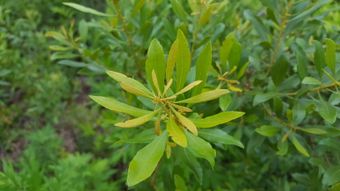Maryland DNR Deer-Resistant Plant
Wax myrtle, formerly known by the scientific name Myrica cerifera, is a large, evergreen shrub whose aromatic leaves and fruit have been used in food, for ornamental value and in historically in herbalism. It is the most common of the three Morella species found in Maryland. It is dense-branching, nitrogen-fixing, suckering, and fast-growing, growing to 10–15’ tall and 8–10’ wide. It is adaptable to many habitats and can weather coastal storms, long droughts, and tropic-like high temperatures. Its root nodules harbor a symbiotic species of bacteria, which fixes nitrogen at a faster rate than legumes do. It tolerates rabbits, deer, drought, and wet soil. Plant is dioecious, with male and female flowers borne in catkins on separate plants. The fruit is a small, wrinkled berry with a pale blue-purple waxy coating. American colonists boiled the berries to extract the sweet-smelling wax, which they used to make candles and soap.
Wax myrtle is native to southeastern and south-central U.S. It is often one of the first plants to colonize an area. It is adaptable to many habitats, growing naturally in wetlands, near rivers and streams, sand dunes, fields, hillsides, and in both coniferous and mixed-broadleaf forests. The fruit is a source of food for many bird species. In Winter, the seeds are extremely important foods for the Carolina wren and species of tree sparrow. Birds' digestive systems remove the wax covering from the fruit, a prerequisite for germination. The plant is also a host plant for various moth species. Plants are either male or female; both plants are needed in order to get fruit, however the plants offered are grown from seed and not yet flowering to determine whether male or female.
Photo by Kathy Thornton

